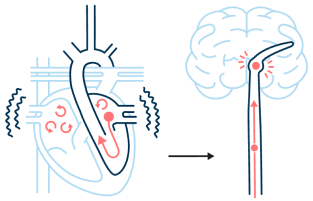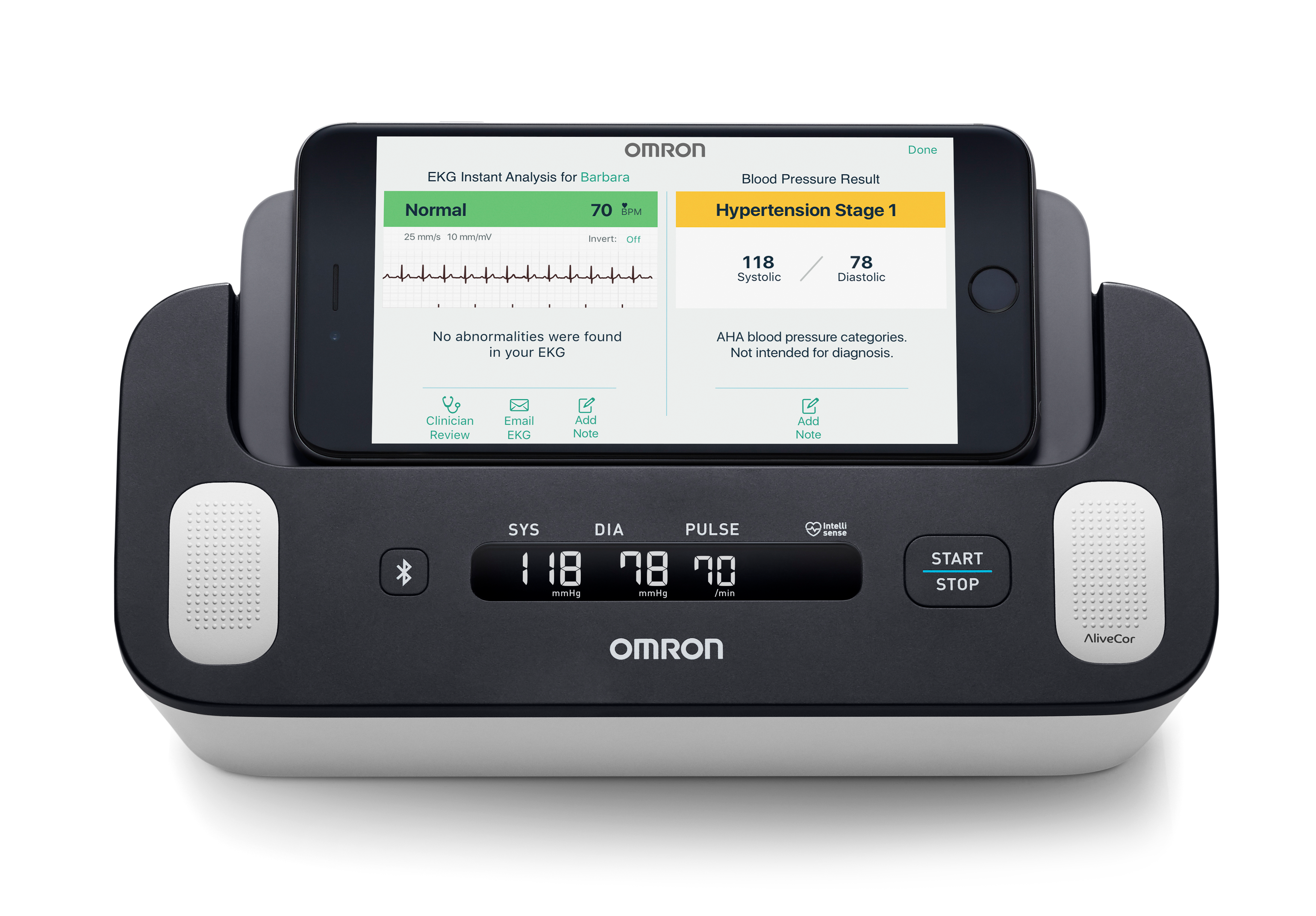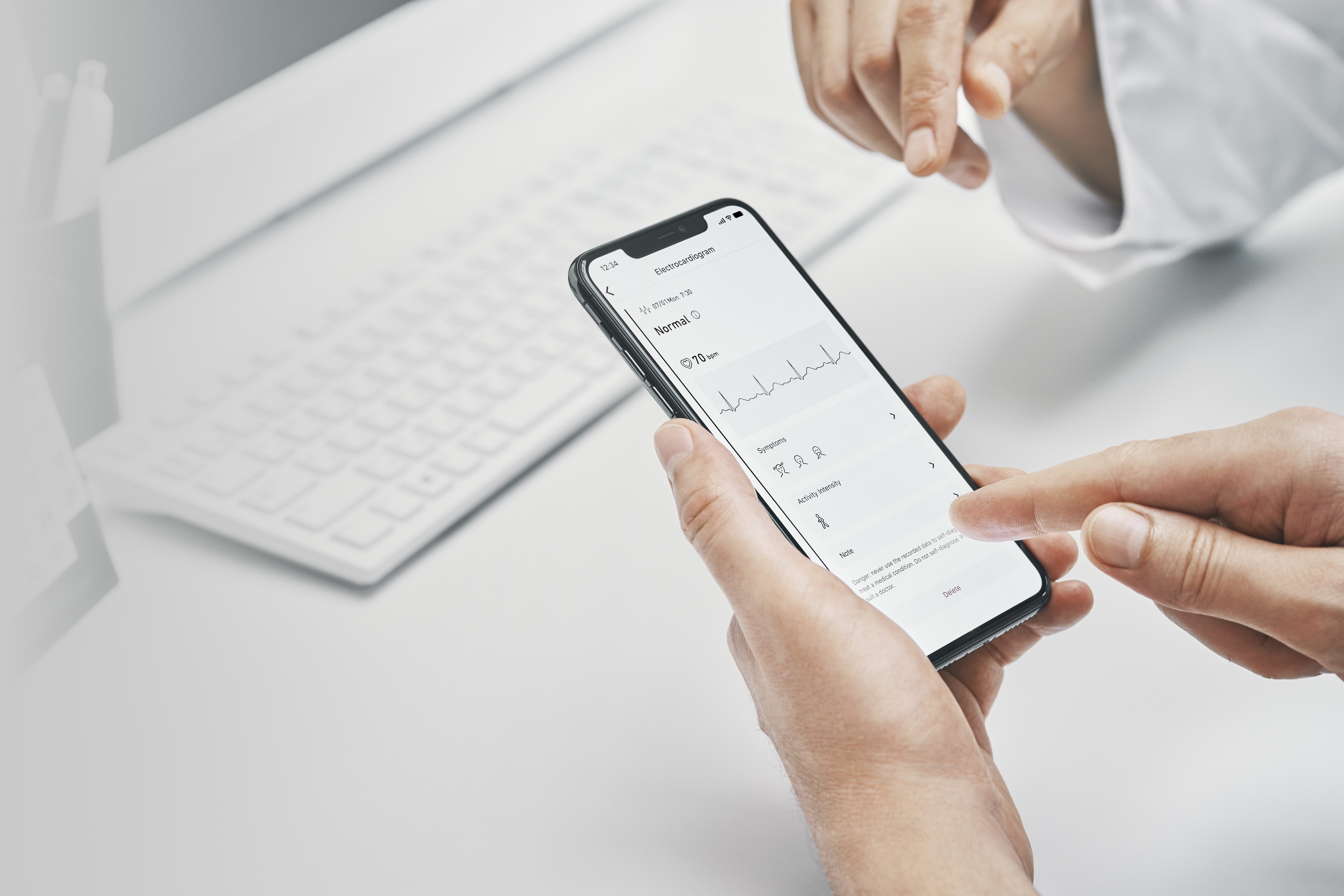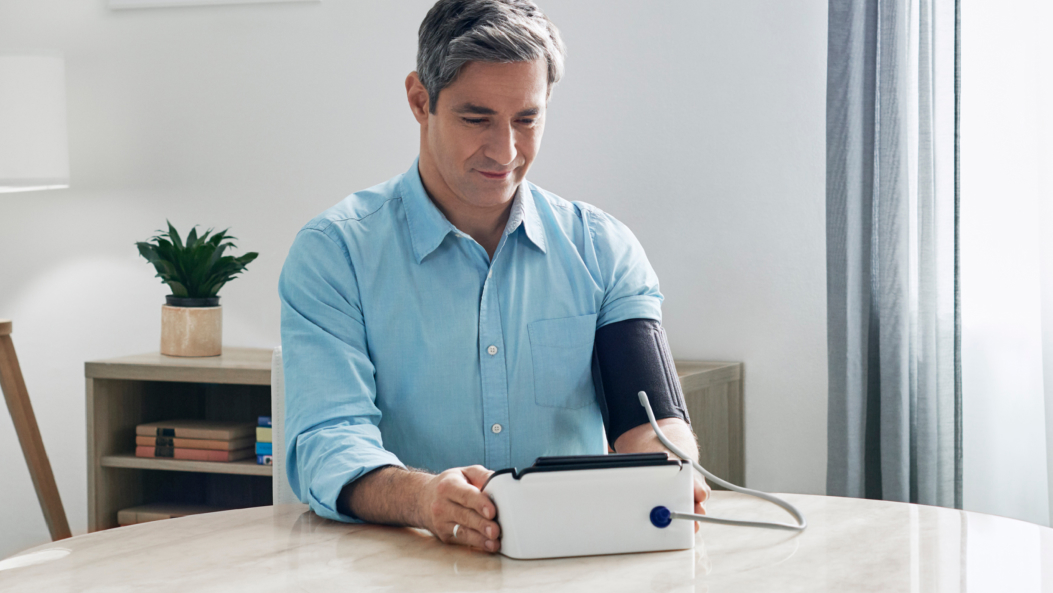Unusual heartbeat?
Our Promise
Don’t let undetected AFib lead to stroke
Early AFib detection is essential. But as the risk of AFib grows with age, its often subtle or mistaken signs leave numerous individuals undiagnosed.
Discover the Sound of AFib.
AFib is a heart rhythm disorder characterized by rapid and irregular heartbeats
Normal heartbeat
AFib
Normal heartbeat
AFib


High blood pressure, or hypertension, is a leading cause of AFib in adults
It’s not uncommon for high blood pressure and AFib to both be present in the same person. In fact, one medical study found the following:
- High blood pressure was found to increase the risk of AFib by 50% in men and 40% in women6
- High blood pressure was the 4th risk factor after heart failure, aging, and heart valve disease6
How it works
Instant, already interpreted results
Traditional EKGs rely on wired electrodes to track heart signals. OMRON advances this with portable devices featuring built-in sensors. By placing their fingers on the sensors, users can facilitate swift heart monitoring; the companion app instantly captures and interprets the EKG results, so there’s no second guessing.
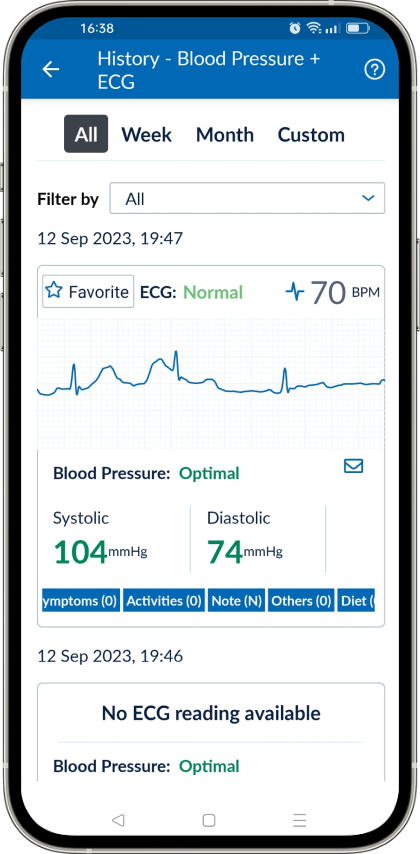
The EKG shows a heart rate of 50-100 bpm,
indicating a regular rhythm without arrhythmias.
Sample results for 1-Lead via OMRON Complete
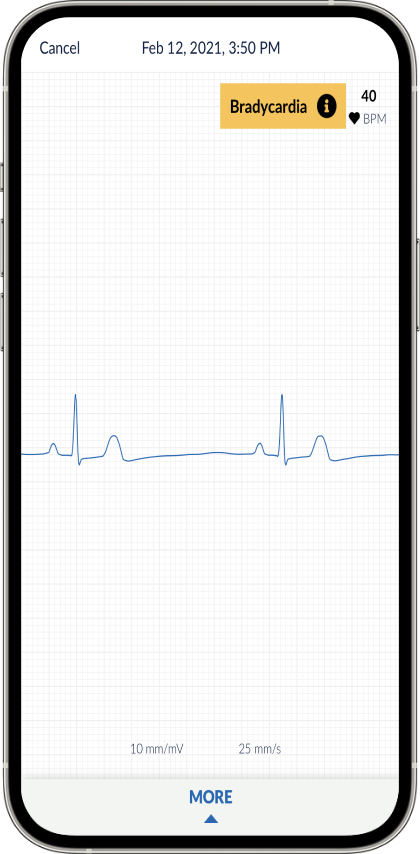
A heart rate of 40-50 bpm with a stable sinus
rhythm has been detected. Monitoring for potential underlying issues is advised.
Sample results for 1-Lead via OMRON Complete
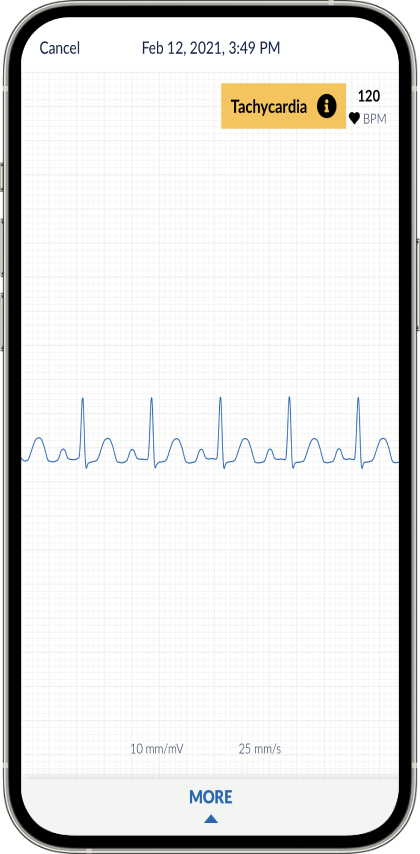
A 100-140 bpm heart rate is detected with preserved
sinus rhythm and no signs of atrial fibrillation. Evaluation for underlying causes is necessary.
Sample results for 1-Lead via OMRON Complete
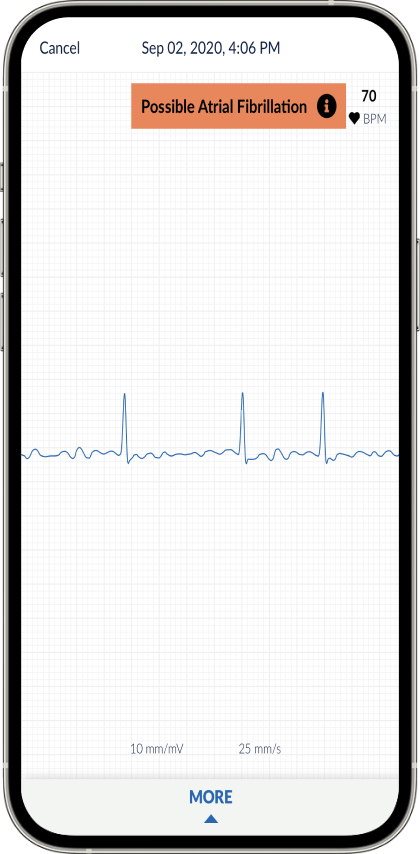
An irregular rhythm that suggests possible atrial
fibrillation is observed. Further evaluation is recommended.
Sample results for 1-Lead via OMRON Complete
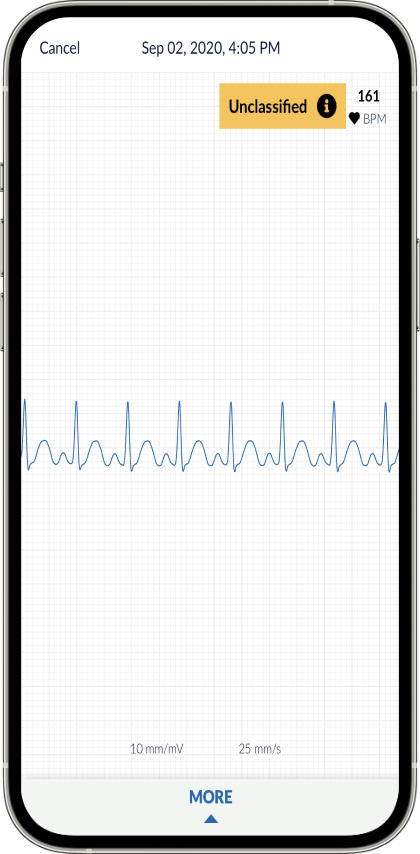
The EKG doesn’t fit standard categories.
Consideration of other arrhythmic presentations or external factors is necessary.
Sample results for 1-Lead via OMRON Complete
Electrocardiogram recording is an effective test to check the condition of the heart, but it does not express all changes and symptoms of the heart. If the analysis results of your records show “normal sinus rhythm” but you still have symptoms, or if “Unable to classify” or “Unable to analyze is repeatedly displayed, please consult your doctor. Self-judgment and treatment based on analysis results is dangerous. Do not judge the recorded results (electrocardiogram waveform) or the messages displayed by analyzing them on your own; consult your doctor. Self-judgment based on analysis results may lead to worsening of symptoms.
How it works
Instant, already interpreted results
Traditional EKGs rely on wired electrodes to track heart signals. OMRON advances this with portable devices featuring built-in sensors. By placing their fingers on the sensors, users can facilitate swift heart monitoring; the companion app instantly captures and interprets the EKG results, so there’s no second guessing.

Sample results for 1-Lead via OMRON Complete
The EKG shows a heart rate of 50-100 bpm, indicating a regular rhythm without arrhythmias.

Sample results for 1-Lead via OMRON Complete
A heart rate of 40-50 bpm with a stable sinus rhythm has been detected. Monitoring for potential underlying issues is advised.

Sample results for 1-Lead via OMRON Complete
A 100-140 bpm heart rate is detected with preserved sinus rhythm and no signs of atrial fibrillation. Evaluation for underlying causes is necessary.

Sample results for 1-Lead via OMRON Complete
An irregular rhythm that suggests possible atrial fibrillation is observed. Further evaluation is recommended.

Sample results for 1-Lead via OMRON Complete
The EKG doesn’t fit standard categories. Consideration of other arrhythmic presentations or external factors is necessary.
Electrocardiogram recording is an effective test to check the condition of the heart, but it does not express all changes and symptoms of the heart. If the analysis results of your records show “normal sinus rhythm” but you still have symptoms, or if “Unable to classify” or “Unable to analyze is repeatedly displayed, please consult your doctor. Self-judgment and treatment based on analysis results is dangerous. Do not judge the recorded results (electrocardiogram waveform) or the messages displayed by analyzing them on your own; consult your doctor. Self-judgment based on analysis results may lead to worsening of symptoms.
Solutions
Catch early warning signs accurately, at home
Monitoring blood pressure and EKG at home plays a crucial role in stroke prevention. It empowers individuals to identify irregular heart rhythms early, allowing for prompt medical intervention and ultimately reducing the risk of stroke.


Early detection, better outcomes
Spotting AFib signs early from home can prevent more serious complications with timely and effective interventions.
Know when to seek help
Home monitoring delivers definitive readings so you’ll know if there’s a heart rhythm irregularity, reducing the stress of uncertainty.
Enhance your doctor’s insight
Reliable and consistent data from home assists in tailoring optimal treatment strategies.
Post-procedure assurance
Helps with monitoring progress after surgical interventions, ensuring care that goes beyond the doctor’s officce.
Catch Warning Signs Early
Clinical Validations
Evidence supports the benefits
Our references
- 1.NHS. Home. Health A to Z. Atrial fibrillation. Available at: https://www.nhs.uk/conditions/atrial-fibrillation/. Accessed May 2023.
- 2.European Society of Cardiology. The ESC. ESC Press Office. Press releases. Available at: https://www.escardio.org/The-ESC/Press-Office/Press-releases/Atrial-fibrillation-set-to-affect-more-than-14-million-over-65s-in-the-EU-by-2060#:~:text=Atrial%20fibrillation%20is%20the%20most,are%20caused%20by%20atrial%20fibrilation. Accessed May 2023. https://www.hopkinsmedicine.org/health/conditions-and-diseases/atrial-fibrillation#:~:text=With%20Afib%2C%20electrical%20impulses%20fire,blood%20and%20pump%20blood%2Onormally.
- 3.Staerk, L., et al. (2017). Atrial Fibrillation: Epidemiology, Pathophysiology, and Clinical Outcomes. Circulation research, [online] 120(9), pp.1501-1517. doi: https://doi.org/10.1161/CIRCRESAHA.117.309732.
- 4.Lloyd-Jones DM et al. Lifetime risk for development of atrial fibrillation: the Framingham Heart Study. Circulation. 2004 Aug 31;110(9):1042-6.
- 5.NHS. Home. Health A to Z. Atrial fibrillation. Available at: https://www.nhs.uk/conditions/atrial-fibrillation/complications/. Accessed May 2023.
- 6.Verdecchia, P., et al. (2018). Hypertension and Atrial Fibrillation: Doubts and Certainties From Basic and Clinical Studies. Circulation research, [online] 122(2), pp.352-368. doi: https://doi.org/10.1161/CIRCRESAHA.117.311402.
- 7.https://www.hopkinsmedicine.org/health/conditions-and-diseases/atrial-fibrillation#:~:text=With%20Afib%2C%20electrical%20impulses%20fire,blood%20and%20pump%20blood%2Onormally.

